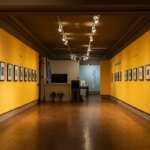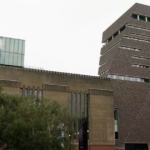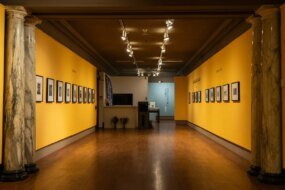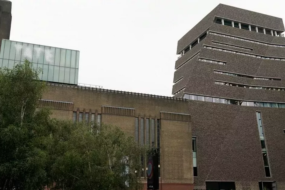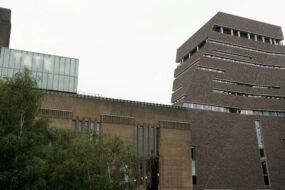
How comfortable is it to be Asian, particularly Chinese, in the European art world in 2025? Intense geopolitical tensions, economic instability, slowdown and the shift to national and regional interests rather than globalised ones have put the most recent orthodoxies in question. The art world does not float free above these ‘new world’ imperatives.
Of all European cities, Berlin may be the best testbed – especially during Gallery Weekend – to understand how Chinese artworld professionals see their place in this ‘new’ Europe. After all, Berlin has been a welcoming destination for Chinese artists since the 80s, when a generation moved here, tempted by scholarships and residencies. The Beijing-based artist Tan Ping had a DAAD scholarship, was taught by Georg Baselitz and remembers that in the 80s, four-fifths of galleries showed abstract art. We also asked the artist Qin Yufen (秦玉芬) for her 80s memories.
‘The artist-in-residence program we participated in—DAAD—had, since the 1960s, invited prominent artists, filmmakers, musicians, and writers from around the world to live and create in Berlin. Though the city was like an isolated island surrounded by the Berlin Wall, it still hosted highly experimental contemporary art exhibitions and maintained a vibrant artistic atmosphere. Joseph Beuys and Nam June Paik were frequent visitors to Berlin. At the time, West Berlin gathered many active German Neo-Expressionist painters and Fluxus artists, along with electronic music, experimental theatre, and more… As the former mayor of Berlin once said, “Berlin is poor but sexy”.
Later generations of Chinese artists have continued to arrive, tempted not only by German government support but also by inexpensive art school and university education, cheap rents and the city’s reputation as an ‘open’ place for lifestyle and cultural experimentation. On our way into Berlin from London for the Gallery Weekend, we are caught in a ninety-minute passport queue and talk with a Pakistani national who has been working in Berlin for three years for a digital company. He tells us that Berlin is two cities – the daytime one and a wholly different one at night. His tone is something between awed and bewildered. Berlin’s legendary club life is clearly alive and well to this citizen, even if rising rents, gentrification and commodification threaten the scene.
Like many other cities – from Beijing to London – Berlin stages a Gallery Weekend for a variety of reasons: to give gallery-going which is a declining habit, the character of a special, time-limited and unmissable event; to attract the attention (and credit cards) of national and international collectors – and to generate media coverage, part of the lifeblood of the artworld. We have been invited to Berlin courtesy of Sutton, who is also the Communications representative of Art Basel.
Since the 1980s, Germany has been the powerhouse of Europe, but it is now in economic and political trouble, and Berlin, its cultural heart, is suffering. The Israel/Hamas war has riven Berlin and led to the cancellation of exhibitions; and there has been a twelve per cent reduction in arts funding (130 million euro cut), which some think tolls the cultural death knell of Berlin. Residency and studio programmes have certainly been cut, and the traditional generous funding of museums is under huge pressure, with talk of closures.
It is into this ‘new Berlin world’ that we fly, if only for thirty hours. We have scheduled face-to-face conversations with Chinese artists and gallerists, and talked with others down the line before we leave for Berlin. The Schengen visa system allows Chinese artworld professionals to move across EU countries. Repeatedly, we hear the phrase ‘floating society’ ( 流动社会), most fervently from Chen Dan (陈丹), owner of NADAM gallery, to describe Chinese artworld professionals’ relationship with Berlin. Liang Zhenru (梁真如), who is studying for an MA in Berlin’s Universität der Künste, also lectures at the Accademia di Belle Arti di Brera in Milan. Lu Mei (卢玫)of Migrant Bird Space arrived in Berlin fourteen years ago from Holland and now wonders about a move to London. Lu Mei tells us she knows Chinese Berlin-based artists who are returning to China – at least in China, there are more opportunities to work with brands, they say. Another Chinese, who would prefer to remain anonymous, says, on the contrary, that Chinese artists are leaving China and coming to Europe. Maybe both accounts are true.
Globally, the art market is undergoing a ‘correction’, to use artworld speak, which means sales are slow, the highest priced artworks declining precipitously from stratospheric levels and galleries closing. Lower-priced artwork sales are rising, though. In one sense, these market changes ought to matter less to Berlin, which has never been an art market hub, than to an art market city such as Cologne. A Berlin gallerist jokes to us that there are no collectors in Berlin.
In the official programme of Gallery Weekend are fifty-two galleries, but as Hua Xiaochan, co-founder of Hua International, with spaces in Beijing and Berlin, tells us, hers is the only Asian owned gallery in the programme. This does not mean there are no other Chinese-owned galleries in Berlin. Migrant Bird Space and NADAN are two others.
It is a sign of the times that only one of the Chinese-owned galleries with whom we speak is currently exhibiting Chinese artists as part of a thematic show. Chinese artists are part of the portfolios of Chinese-owned galleries, but they aim to show artists worldwide. There is nothing wrong with this – art from China is being integrated into the global story of contemporary art. But it is also the case that the category ‘China’ is now viewed more cautiously in Europe. The Berlin-based artist aaajiao was set up with six other initiators, the Asian Artists Association in Berlin. Still, it didn’t prove very easy, and none of the initial group members are now members. Political differences were part of the reason for their withdrawal.
Ten or fifteen years ago, the situation was different – China was on the rise, Chinese art was a global fashion, and auction houses were eager to promote Chinese contemporary art: ‘Contemporary Chinese Art Looms Large in Sotheby’s London Lineup’ was Jing Daily’s headline in 2013. The artist Qin Yufen remembers unsentimentally and wryly when ‘Chinese symbols and the art market led to a brief moment of fame for Chinese art in Germany’. She is not sorry the moment has passed.
Now, with auction houses and galleries withdrawing from promoting the distinctive Chineseness of Chinese art, only governments seem to remain committed to such a category, as can be seen in the recent Pompidou exhibition ‘目 China. A new generation of artists, where aaajiao was featured (he is now in the Pompidou collection). It was an official part of government to government celebrations between France and China A partner was Chanel.
Talk to a Chinese artist in Berlin and they want to talk about their art rather than their Chineseness. Duan Yafeng (段亚峰)is an abstract artist who has lived in Berlin since 2009. She tells us that she asked her CAFA professor where she should go to study abroad. Paris or Berlin was the answer. She went to talk to the French and the German embassies; arrived in Germany in 2004, and five years later moved to Berlin, where she still lives. The approach of Germany to art was more profound, she thought, and education was much cheaper. She has exhibited in various countries such as Switzerland, Germany, China, and New Zealand, and there is an upcoming show at Tang Contemporary with two other artists in Hong Kong.
Throughout the conversation, she is insistent that she does not want to be compared with other artists and that she has developed her own practice.(我走了我自己的路)

The variety of artists shown by Chinese-owned galleries in Berlin during the Gallery Weekend is interesting. Hua International has a show of a Berlin based Iranian queer couple Tirdad Hashemi and Soufia Erfanian, together with the Berlin based Mahsa Saloor; NADAN Gallery has an exhibition of sculptural works by the Berlin based Korean artist Shinoh Nam ( prices range from 1500 to 28,000 Euro); and Migrant Bird Space has a cross-cultural show bringing together European and Chinese artists under the rubric ‘Emptiness of the Four Elements’ .
It is interesting that it is a commercial gallery staging a cross-cultural exhibition – the Hamburger Bahnhof has a one-person show of the Czech artist Klara Hosnedlova (sponsored by Chanel’s culture fund), and the State Neue Nationalgalerie has an exhibition of Yoko Ono. Solo shows are more attractive than cross-cultural shows to public sector spaces that now need to attract paying visitors to offset the reduction in grants. It is also the case that many Western curators largely don’t know the history of modern and contemporary art from China or Asia, so it is difficult for them to mount cross-cultural shows. One of the reasons that Ai Weiwei is everywhere in Europe (and of course, he lived in Berlin for five years) is that he is a known quantity.
To be fair to everyone, as Hua Xiaochan tells us, it is also not necessarily easy to source information about Chinese contemporary art if you do not read Chinese. It is also not always easy to post art information on YouTube, WhatsApp, etc from China. A big current artworld story in China has been the arguments over Madein Gallery. We can find nothing about this story in the Western media.
In the present circumstances, galleries with spaces in China and in Berlin become ever more important. Hua Xiaochan (whose gallery prices range from 5000 to 35000 Euro) tells us that she maintains the same roster of artists in both spaces, but presents different exhibitions tailored to each location and that there is a supportive LGBTQ+ community in Beijing with whom she is networked. With a gallery home in Beijing, she tells us she feels at home in Berlin, another northern city – both capitals are ‘rough’, she says as a compliment. A further attraction of Berlin for her is that it is a place for artists (rather than the art market) – and as someone trained as an artist herself, she likes its identity. She does not disguise that it has not always been easy being a Chinese woman art gallery co-owner in Berlin (her partner is German). She recounts an occasion early in her Berlin career when she introduced herself and two of her German colleagues to an artworld professional in Berlin. The guest asked where the gallery owner was – beyond his comprehension, a young Chinese woman could be the owner.

Of course, it is not only Chinese galleries interested in Chinese art. Esther Schipper Gallery (the German owner was born in Taiwan) opened an exhibition of Sun Yitian (孙一钿) at the same time as one of Merikokeb Berhanu as its Gallery Weekend offer (Sun Yitian prefers not to disclose her price range). This was the third exhibition that Schipper has given to Sun Yitian – previous ones have been in Paris as well as Berlin. It was very noticeable that the majority of visitors in the Sun Yitian space were Chinese. A white European might look at Sun Yitian paintings and see only a late version of European surrealism. But when we talk to the artist herself, she is eager to explain that any Chinese viewer would understand that as a Wenzhou inhabitant, her ambitious painting, with a shoe metamorphosing into a fish, is in part a reference to her own city’s shoe production. The shoe is a copy (jingpin) of an iconic designer shoe. What is real? What is fake?
Sun Yitian is a visitor to Berlin and is politely complimentary about its wildness and openness. The wildness of her own paintings is articulated indirectly through the tension between the paintings’ content and the deliberately flat formality with which she paints.
Sun Yitian will go home to Beijing, as we shall to London. Home and belonging are complicated matters in the contemporary world for all of us, perhaps particularly so for the Chinese living in Berlin.

Illumination about the identity of the Chinese artworld professionals in Berlin came oddly enough in a conversation with the German born artist of Vietnamese descent Phung-Tien Phan whose show ‘Kein Character’ is at Schiefe Zähne – part of Gallery Weekend (prices from 4000 to 9000 Euro; two of her works have recently been collected by the new museum DIB Bangkok). Hers is a witty show, placing small soft toy dinosaurs in different mise-en-scène, gently mocking the received masculinist version of the dinosaur. She describes herself as German+, even though she was born in Essen and still lives there. She explains that she has a double filter in her mind, which provides the basis of her distinctive vision.
Chinese artworld professionals in Berlin, too, have a double vision – but there is no settled way to describe that vision. The traditional term is ‘diaspora’ – but as Chinese artworld professionals often move between Berlin and China, it doesn’t feel quite appropriate. Transnational is now the accepted academic term and is used by Liang Zhenru. When we visit aaajiao in his flat, he talks about identity. He says there are 20,000 Chinese in Berlin, including students (the student figures are notoriously unreliable everywhere), and this population in the context of a city of nearly four million inhabitants is agonisingly small.
‘I began to think of Berlin as home during Covid, ’ he says. ‘I felt safe here despite the deaths and illness’. It is Berlin, not Germany, that he can imagine as home. ‘Berlin is a bubble’, he says, ‘so unlike the rest of Germany’. But he knows he can’t be a European – and to clarify his position, he says he is still concerned with the Chinese people, contrasting it with his concern with German society. He likes the idea of Sinophonia, as theorised by Shu-mei Shih, defined, very simply, as cultural products on the margin of China and Chineseness.
This question of the Chinese in Europe – including the place of Chinese art professionals in Europe – is likely to become ever more urgent in the near future. The old European idea of multiculturalism has never really embraced the Chinese. In the future, with the demanding geopolitical world, the relationship of the Chinese in Europe to the European landscape will be complex for both the Chinese, whether born on the continent, permanently living or simply studying here, and the other populations across Europe.
In the meantime, the Chinese artworld professionals in Berlin will speak in their various voices – and perhaps it is the variety of those voices which is the way to the future.
Top Photo: Portrait of Hua Xiaochan
With thanks to Thomas Eller – Philip Dodd

